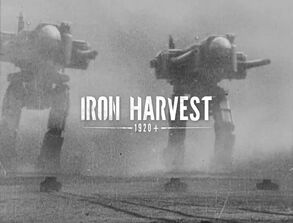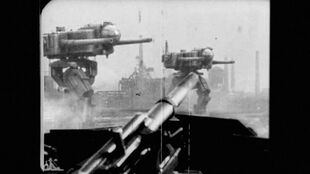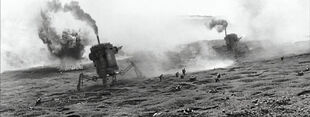
The Great War was a devastating international conflict which took place from 1915-1920 in the 1920+ universe, paralleling World War I (which we also call the Great War) in our timeline with some differences. The war to end all wars, it saw previously unheard-of levels of destruction and untold loss of human lives.
Scythe History[]
It is worth noting that compared to Iron Harvest in Scythe the length of the war itself, when it started or ended, are unknown, but it was as devastating as it was world-changing. Entire cities were leveled, the populations of all the countries involved were more than decimated, and the very landscape would never be the same again. Not only were massive armies pitched against each other, but advances in artillery, armor, explosives, and fully-automatic weapons like heavy machine guns wreaked immense losses. Worst of all, however, were the auto-machines; mechs, which each country produced and weaponized, brought perhaps the greatest changes, ones still seen and felt after the war.
In the aftermath of the war, wreckages of mechs, other vehicles, twisted lengths of barbed wires, and many lost souls still litter the landscape, and the process of salvaging these resources became known as the "Iron Harvest."
Participants[]
- Polania Republic
- Saxony Empire
- Rusviet Tsardom
- Togawa Shogunate
- Crimean Khanate
- Clan Albion
- Nordic Kingdoms
- Fenris
Iron Harvest History[]
The war was the culmination of national tensions and desire for expansion for the great powers. Little did their respective governments known, however, that they were being manipulated by an unseen force working in the background to spark conflict and seize power in the process.
In 1915, the assassination of a Saxony archduke finally lit the powder keg waiting to blow, and the nations went to war one after the other. Their armies of men and conventional weapons were bolstered by automachines, mechanical walkers of all shapes and sizes initially given by Tesla but since augmented for wielding weapons from machine guns and flamethrowers to earth-shatter cannons and missiles. These mechs wiped out hundreds of men at a time, leading to many millions of casualties. Despite all the deaths, much of the war was a seemingly meaningless push and pull as the sides fought and paid dearly to take ground only to lose it shortly after, and the cycle would repeat itself as the terrain itself was rendered unrecognizable.
Despite the carnage, more and more men were pulled from reserves and thrown into the meat grinder, encouraged and indoctrinated with propaganda, promises of adventure, and assurances that their side was the right one. Polania would need all the help it could get in the face of invasion, as would Frankish, Italy and the Crimean Khanate; brave efforts would not be enough to ever truly halt the Saxonian advance which stalled but never grinded to a true halt since the war's beginning. Recognizing this fact, besides Rusviet seeing success against it's lesser enemies compared to the Western Allies, moved to produce a ceasefire and consolidate it's political position.
Finally, in 1920, all the powers agreed to a ceasefire in St. Petersburg, bringing an end to the needless carnage. In the near term this placated revolutionary fervor yet still had long-term consequences of its own: many citizens of all statures in these countries were left furiously besides themselves; seeing this as a blow to national pride, their honor, and perceived superiority to other nations.
Members of the Saxony Empire in particular were mad with rage: many saw Saxony as giving its enemies undeserved concessions in an otherwise victorious effort on their part against all odds. Expansion and conquest were their militarist birthright and certainty that total victory was near only to be thrown away was a real belief, therefore significant elements in the Empire were dissatisfied with what were perceived as unfavorable conditions of ceasefire. In a way Saxonian ambitions were 'betrayed' by Kaiser Friedrich's lack of desire to expand further, a fact which Prince Wilhelm would later exploit to seize the crown in the war's aftermath; nations were left in largely haphazard, economically devastated conditions with rumors of revolution in the air and drastic change likely on the horizon.
Now forces working from the shadows aim to take advantage of the hostile sentiments to once again push the nations to war, a war that would possibly make the Great War pale in comparison as all sides push to bolster their technological prowess and military strength.
Participants[]
Saxon Allies[]
Rusviet Allies[]
Neutral[]
- Polania Republic (Invaded simultaneously by Rusviet and Saxony at the start of the war)
- Usonia (Limited action before the end of the war when its several volunteer divisions fought under Frankish, Albionion or Polanian command.)
- Fenris
Events[]
1915[]
- Outbreak of war in the winter season
- Saxony invades Polania in Operation "Sonnenaufgang"
- Rusviet invades Polania
- The Crimean Khanate, Togawa Shogunate, and Nordic Kingdoms mobilize for war
- Trench warfare stalemate ensues
1917[]
- A truce is called between Rusviet and Saxonian forces for Christmas Eve
- Crown Prince Wilhelm's forces gas Rusviet fortifications: stalemate broken, Saxony gains ground
1919[]
- Wilhelm massacres Rusviet POWs
- Gunter von Duisburg subdues him forcefully and attempts to expose the action, but is disgraced as a result
- Gunter retires from military service due to the scandal
- Battle of Grabowo, Saxons attempts to break through Rusviet lines: Saxony defeat.
1920[]
- Peace talks in St. Petersburg begin, interrupted by a failed revolutionary coup instigated by Grigori Rasputin
- Forces from Nikola Tesla intervene
- Nikola Tesla uncovers Fenris involvement and warns national leaders
- Continued talks succeed: Saxony and Rusviet agree to a ceasefire as do all other active belligerents
- Part of Polania is occupied by Rusviet
Unknown[]
- Battle of Castle Książ, with Polania defending against Saxony (Outcome unknown)
- Battle of the Somme/The Somme Offensive (Outcome unknown: likely no clear victor and massive casualties, see Trivia)
- Battle of Verdun (Outcome unknown: likely a Frankish victory, see Trivia)
- Albionian entrance into the War
- Usonian entrance into the War
- Togawan action against Rusviet (see Trivia)
- Italian entrance into the war (see Trivia)
Trivia[]
- In Iron Harvest, Fenris claims responsibility for the shooting of "that archduke" (likely Archduke Ferdinand), likely starting the Great War which suits their agenda. Given that the war started in 1915 it seems Ferdinand's assassination in 1914 either failed or was moved to a later date.
- Considering multiple territories consisting of the Austro-Hungarian Empire are shown to be part of the Saxony Empire it's entirely possible Franz Ferdinand was a Saxonian Archduke in 1920+ rather than an Austro-Hungarian one as he was in real life.
- The war spanning 1915-1920 simultaneously shares similarities with and greatly differs from the real first World War spanning 1914-1918, with noticeably different results in Iron Harvest compared to Real Life. While the conditions and context of surrender are similar, neither Rusviet or Saxony cease being monarchies, while Russia and Germany both saw revolts that took them from being the Russian and German Empires to the Soviet Union and Weimar Republic, respectively.
- It is worth noting that unlike Saxony, Rusviet suffers from multiple revolutions and revolts soon after the conclusion of the Great War one of which the Tsar is outright overthrown.
- Multiple post-war events also echo this history:
- The post-war Polanian revolt against Rusviet has multiple similarities to the real life Polish-Soviet War (1919-1921) albeit shorter and in reverse with Rusviet on the defensive rather than the attack.
- Saxony occupies Arabia much like France occupied Syria after the war, resisting it's own Arab Revolt with Usonian rather than British backing.
- At the end of the introduction to the Polania campaign with Anna, we can see scrolling archive images illustrating the "Great War", these images are mostly images from real archives of the First World War, some being slightly modified to include mechs alongside ordinary soldiers. Among these images are some showing light tanks as well as German soldiers wearing the Stahlhelm helmet, which replaced the Pickelhaube helmet from 1916 in the German uniform. However the Saxonian soldiers all wear Pickelhaube helmets, without it being explained why this change took place or these images showing Stahlhelm are simply an inconsistency with the universe of Iron Harvest. The presence of non-mechanized vehicles is another mystery as auto-machines are shown to serve in an almost interchangeable capacity in cutscenes (such as the Isegrim, Kaiser, or automachine bus and supply)
- In real life both the Battle of Verdun and the Somme Offensives occurred in 1916.
- Without formal Usonian intervention (therefore no possibility for a parallel to the real Hundred Day Offensive) it can be presumed their volunteers were present at both battles
- The Somme Offensive was a joint British and French Military effort hoping to hasten the end of the war and instead becoming one of the deadliest battles in recorded human history with potentially 1.2 million casualties minimum.
- The Battle of Verdun was a move by the German Army hoping to maximize French casualties and break their military with mixed results and becoming a rallying moment for the French instead.
- If Italy did participate in the War, and lost (as seen on the Scythe Map), then the Battle of Isonzo must have also occurred though at an unknown date and unknown number of times(there were 12 Battles for Isonzo in real life 1915 - 1917)
- Japan assaulted the German colony of Qingdao in China in 1914 with the assistance of the Royal Navy, one can assume Togawa Shogunate instead did a similar amphibious assault against Rusviet for Saxony but where or when is unknown
- The Great War of 1920+ does not seem to have a dynamic of Central vs Allied Powers unlike real life: for example, Austro-Hungary is not independent and the Ottoman Empire does not exist replaced instead by the Crimean Khanate which seems to lose against Rusviet (like Polania). Both Rusviet and Saxony invade Polania (Like WWII.) despite them lacking any common allegiance in addition to Rusviet warring with Saxony, Usonia helps nations invaded by both Rusviet and Saxony yet doesn't formally "pick a side" behind either, curiously having volunteers serve under Frankish, Albionian, and Polanian command instead. This leaves the Nordic Kingdoms which is implied to be formally allied to Rusviet yet are conspicuously absent from the Peace Talks established by the Tsar, the Togawa Shogunate who are present at the peace talks and fought against the Rusviet Union(rather than Germany IRL), Arabia which becomes a Saxonian Protectorate, lastly Clan Albion who fought against Saxony (explicitly with Frankish and Usonian Volunteer forces) and are present at the peace talks.
Gallery[]
| Lore | ||||||||||
| General | Factions | The Factory | ||||||||
| World of 1920+ Airship |
Playable Polania Republic Saxony Empire Rusviet Tsardom Federal Union of Usonia Featured(Non-Playable) The Factory Fenris Arabia Clan Albion Togawa Shogunate Frankish Italy Mentioned Only Nordic Kingdoms Crimean Khanate United States of Aztlan Dominion of Laurentia Hispania |
Nikola Tesla Vesna Tesla | ||||||||
| Polanian Characters | Saxon Characters | Rusviet Characters | ||||||||
| Anna Kos Wojtek Piotr Kos Lech Kos Janek Kos Michal Sikorski |
Gunter von Duisburg Nacht and Tag Prince Wilhelm of Saxony Frieda Ruete Kaiser Friedrich of Saxony Heinrich Steinmetz General Sturmm
|
Olga Romanova Changa Grigori Rasputin Tsar Nicholas Viktor Popov Lev Alekseevich Zubov Viktor
|
||||||||


